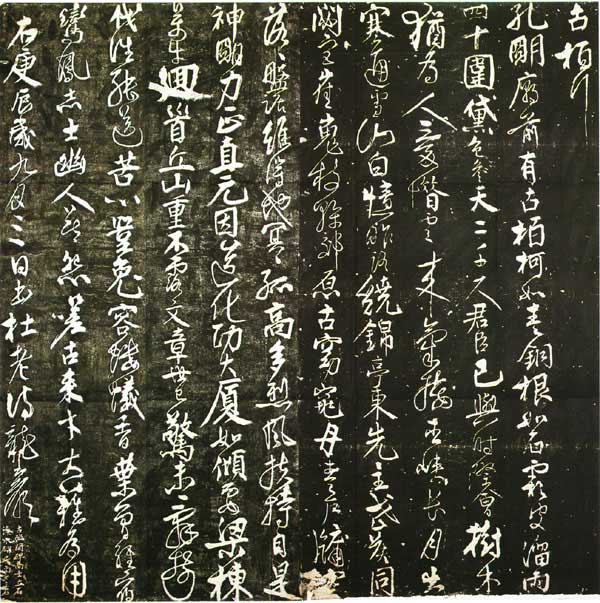Ren Xun (1133-1204), whose courtesy name was Junmo, also known as Longyan, and Mr. Nanlu, was from Yizhou (now Yi County, Hebei). In the second year of Zhenglong (1157), he became a Jinshi. He was a judge in Yidu and a salt envoy in Beijing. He died in his seventies. Wang Tingyun is a master of both poetry, calligraphy and painting. He is a landscape master and is good at calligraphy in both genuine and cursive styles. "Supplementary Collection of Zhongzhou Collection" records: "He was a man of many talents. At that time, people rated painting as higher than calligraphy, writing as higher than poetry, and poetry as higher than literature. In his later years, his family collected hundreds of scrolls of poems and paintings and thousands of poems, but they were all lost later. "History of the Jin Dynasty. Biography of Ren Xun" says that he was "a very generous man, and his calligraphy was the best at that time." This shows that he had a certain influence on his calligraphy at that time. He played countless works in his life, but his works handed down from generation to generation are very rare. Only a few fine works such as "The Row of Ancient Cypresses" and "Lv Zheng's Tomb Table" are seen by today's people.
Ren Xun is the master of many calligraphy masters, and his calligraphy is Zhong Ling Yuxiu. In Ye Changchi's "Yu Shi", he commented on his "Stele Inscription of Datian Palace Temple": "It is sudden and majestic, with thousands of walls standing on it." Zhou Tianqiu, a Ming Dynasty man, wrote in his postscript "Autumn Huai Poems" that he was "the original sect of Huai Su". The calligraphy is vigorous and vigorous. The style is between that of Yan Zhenqing and Su Shi. Later, people talked about Ren Xunshu as his ancestor Lu Gong. For example: Wu Qizhen said: "The calligraphy is majestic and the structure is elegant, and it is the ancestor of Yan Lugong" ("Books and Paintings"); Gu Fu thought: "Jun Mo's calligraphy said that he was good at learning from the plains" ("The Spectacular Life") and so on. Ren Xun studied Yan Zhenqing, so Ren Xun's calligraphy works were mostly vigorous. Many celebrities at that time had a common understanding of the vigorous atmosphere of his calligraphy. Zhao Bingwen said of his calligraphy: "'How is Dai Zong's husband? Qilu is still young.' 'What's the husband' is barely an idiom, but it is not three characters. It cannot make the following sentence have the atmosphere of hundreds of miles. ... Those who learn from Nanlu , you should take this as a reference." (Collected Works of Xianxian Old Man Fu Shui). Yuan Haowen praised his calligraphy as "flowing clouds and flowing water, which have their own unique charm". Wang Yun said in "The Complete Works of Mr. Qiujian" that his calligraphy is "between Yan (Zhenqing) and Po (Su Shi)", "bold and flying". , beyond the norm" and so on, all fully affirmed the momentum of Ren Xun's works.

Rubbing of Du Fu's "A Row of Ancient Cypresses" in running script (click to enlarge) Collection of the Fujii Yuri Collection, Kyoto, Japan
Explanation:
There is an old cypress in front of the Kongming Temple, with roots like bronze and stone.
The frost-skinned rain is forty around, and the dark color towers two thousand feet into the sky.
The king and his ministers have met each other, and the trees are still cherished by others.
The clouds are coming and the Wu Gorge is long, and the moon is cold and the snow-capped mountains are white.
I recall that yesterday the road went around the east of Jinting Pavilion, where the former lord Wuhou Tongcheng Palace was located.
The branches of Cui Wei are ancient in the suburbs, and the houses with beautiful paintings are in the sky.
Even though he has gained the ground, he is so lonely and solitary that there are strong winds.
Supporting oneself is the power of God, and the source of integrity is the work of creation.
The building is like a leaning beam, and thousands of cows are looking back at the mountains.
The world will be shocked if you don't reveal the article. Who can send it if you don't say goodbye to the cutting?
The painstaking efforts will inevitably lead to ants, and the fragrant leaves will eventually pass through Luan Feng.
People with lofty ideals should not complain. Since ancient times, great difficulties have been used.
Du Lao's poem written in Longyan on September 3rd, the year of You Gengchen
Written in the fifth year of King Zhenglong of Hailing (1160), the spirit of this book owes much to Yan Zhenqing. We can even find the shadow of Yan Zhenqing's "General Pei" in it. Ren Xun enjoyed a great reputation in the early Jin Dynasty and was praised as the number one, but there is still a problem that his works have not been adapted to ancient times. In fact, later critics also pointed out problems in Ren Xun's calligraphy. For example, Yuan Haowen believed that he "learned from Dongpo but was a little restrained" ("The Complete Works of Yuan Haowen"), and Wang Yun also said that "his big books are often solemn in style but sluggish in spirit" ("Collected Works of Mr. Qiu Jian") Such views, etc., have clearly pointed out Ren Xun's shortcomings. As far as Ren Xun himself is concerned, he is definitely not a first-class calligrapher in the history of calligraphy. Even in the Jin Dynasty, he was not satisfactory. However, in the early Jin Dynasty, even compared with other calligraphy masters in the Southern Song Dynasty, the momentum of Ren Xun's calligraphy was still considerable. This was Ren Xun's success and the significance of his calligraphy.








